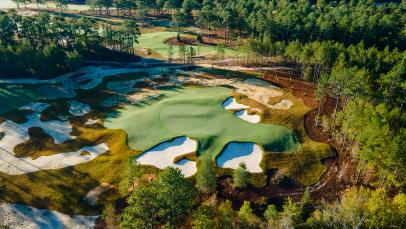Our Pinehurst #2 drone tour reveals the subtle brilliance of this iconic U.S. Open course – Australian Golf Digest

- by Admin
- May 28, 2024

Let’s be frank: the merits of Pinehurst No. 2 can fly right past most golfers. Everyone who visits the resort wants to play the fabled No. 2, ranked 29th on America’s 100 Greatest Courses, but many who do leave thinking either it’s too brutally difficult, or they don’t get the fuss.
There are no long-range vistas, no bunkers that look chiseled from marble and no breathtaking water holes. The design’s brilliance resides not in the spectacular but in the subtle and the degrees that small distances—feet, inches—can result in vastly diverse shot outcomes. Getting on the wrong side of a slope or contour can mean the difference between a par and double bogey. Pinehurst No. 2 is the sum of a thousand small parts that look the same but function differently to create a machine that slowly grinds away scores, one fractional stroke at a time.
Though the Pinehurst No. 2 that we know today dates to 1935, the year all the final pieces were put into place including architect Donald Ross’ conversion of the old flat sand greens to voluptuously contoured Bermuda grass putting surfaces, it didn’t host a U.S. Open until 1999. But since then it’s become a mainstay in the USGA rota—and is now an anchor site that hosts its fourth Open this June and will do so again in 2029, 2035, 2041 and 2047.
More from Golf Digest New Courses I got to play Pinehurst #10—it’s unlike anything I’ve seen
Famous for its crowned greens, No. 2 presents an extreme challenge to anyone trying to shoot 68 because the line between a good shot and a disaster is as fine as it gets in major championship golf outside of Augusta National. To make birdies, players must take on difficult hole locations with unerring control and precision, one green after another. But the beauty of the course is that, with little alteration to the setup, it can play relatively easy for resort guests if they can competently drive the ball into the generous fairways and use their putters around the greens. For them the rule is simple: Keep the ball on the ground, and play to the middle of the greens.
RELATED: Our 10 favorite Pinehurst courses, ranked
Watch our “Every Hole at Pinehurst No. 2” video for more about the mysteries and subtle majesty of this American golf icon.
• • •
Explore Golf Digest’s new Course Reviews section where you can submit a star rating and evaluation on all the courses you’ve played. We’ve collected tens of thousands of reviews from our course-ranking panelists to deliver a premium experience, which includes course rankings, experts’ opinions, bonus course photography, videos and much more. Check it out here!
 Public Pinehurst No. 2 Pinehurst, NC 4.6 447 Panelists
Public Pinehurst No. 2 Pinehurst, NC 4.6 447 Panelists
- 100 Greatest
- 100 Greatest Public
- Best In State
In 2010, a team lead by Bill Coore and Ben Crenshaw killed and ripped out all the Bermudagrass rough on Pinehurst No. 2 that had been foolishly planted in the 1970s. Between fairways and tree lines, they established vast bands of native hardpan sand dotted with clumps of wiregrass and scattered pine needles. They reduced the irrigation to mere single rows in fairways to prevent grass from ever returning to the new sandy wastelands. Playing firm and fast, it was wildly successful as the site of the 2014 Men’s and Women’s U.S. Opens, played on consecutive weeks. Because of its water reduction, the course was named a Green Star environmental award-winner by Golf Digest that year. In 2019, Pinehurst No. 2 and No. 4 hosted another U.S. Amateur Championship, and the USGA announced Pinehurst No. 2—in addition to hosting the 2024 U.S. Open—will also have the 2029, 2035, 2041 and 2047 U.S. Opens. Explore our full review
This article was originally published on golfdigest.com
The Latest News
-
December 25, 2024‘They’re the idiots who picked me’: Aussie skipper’s hilarious message to relieve pressure on new opening sensation
-
December 25, 2024Aussie path to Champions Trophy glory begins with Ashes clash as schedule revealed
-
December 24, 2024‘Good to go’: Head’s cheeky injury jab as ‘unbelievable’ Aussie run machine gets green light
-
December 24, 2024How to watch the NFL in Australia: Full Boxing Day schedule for Netflix’s first ever NFL stream | Sporting News Australia
-
December 24, 2024Cricket 2024: Boxing Day Test Talking Points, India vs Australia, Melbourne Cricket Ground, Sam Konstas debut, Jasprit Bumrah, news, videos, ideas, analysis





